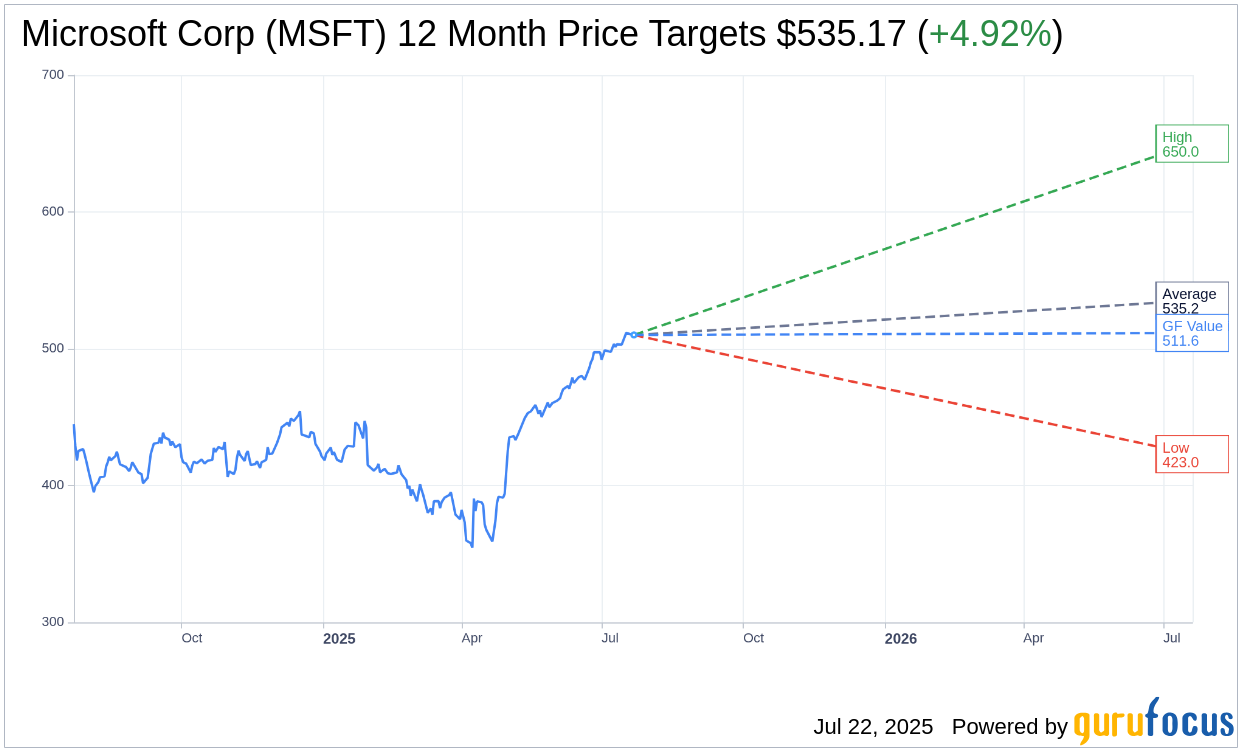Citi's analyst Tyler Radke has increased the price target for Microsoft (MSFT, Financial) shares from $605 to $613, while maintaining a Buy rating. The firm holds an optimistic outlook for Microsoft's performance as the company prepares to announce its fiscal fourth-quarter results. There is notable potential for the company's Azure segment, both for the upcoming fourth quarter and the first quarter estimates. A recent survey conducted by Citi among resellers revealed exceptionally strong feedback for Microsoft, marking the best results in four years.
Wall Street Analysts Forecast

Based on the one-year price targets offered by 50 analysts, the average target price for Microsoft Corp (MSFT, Financial) is $536.29 with a high estimate of $650.00 and a low estimate of $423.00. The average target implies an upside of 5.14% from the current price of $510.06. More detailed estimate data can be found on the Microsoft Corp (MSFT) Forecast page.
Based on the consensus recommendation from 62 brokerage firms, Microsoft Corp's (MSFT, Financial) average brokerage recommendation is currently 1.7, indicating "Outperform" status. The rating scale ranges from 1 to 5, where 1 signifies Strong Buy, and 5 denotes Sell.
Based on GuruFocus estimates, the estimated GF Value for Microsoft Corp (MSFT, Financial) in one year is $511.57, suggesting a upside of 0.3% from the current price of $510.06. GF Value is GuruFocus' estimate of the fair value that the stock should be traded at. It is calculated based on the historical multiples the stock has traded at previously, as well as past business growth and the future estimates of the business' performance. More detailed data can be found on the Microsoft Corp (MSFT) Summary page.
MSFT Key Business Developments
Release Date: April 30, 2025
- Revenue: $70.1 billion, up 13% (15% in constant currency).
- Gross Margin: Increased 11% (13% in constant currency); percentage was 69%, down 1 point year-over-year.
- Operating Income: Increased 16% (19% in constant currency).
- Earnings Per Share (EPS): $3.46, an increase of 18% (19% in constant currency).
- Microsoft Cloud Revenue: $42.4 billion, grew 20% (22% in constant currency).
- Commercial Bookings: Increased 18% (17% in constant currency).
- Commercial Remaining Performance Obligation: $315 billion, up 34% (33% in constant currency).
- Productivity and Business Processes Revenue: $29.9 billion, grew 10% (13% in constant currency).
- Intelligent Cloud Revenue: $26.8 billion, grew 21% (22% in constant currency).
- Azure and Other Cloud Services Revenue: Grew 33% (35% in constant currency).
- More Personal Computing Revenue: $13.4 billion, grew 6% (7% in constant currency).
- Capital Expenditures: $21.4 billion.
- Cash Flow from Operations: $37 billion, up 16%.
- Free Cash Flow: $20.3 billion.
- Return to Shareholders: $9.7 billion through dividends and share repurchases, up 15% year-over-year.
For the complete transcript of the earnings call, please refer to the full earnings call transcript.
Positive Points
- Microsoft Cloud revenue surpassed $42 billion, up 22% in constant currency, showcasing strong demand for cloud and AI offerings.
- Azure and other cloud services revenue grew 33% and 35% in constant currency, driven by strong demand for AI services.
- Microsoft 365 Copilot usage tripled year-over-year, indicating strong adoption of AI-driven productivity tools.
- LinkedIn revenue increased 7% and 8% in constant currency, with significant growth in LinkedIn Premium subscriptions.
- Gaming revenue increased 5% and 6% in constant currency, with Xbox content and services revenue growing 8% and 9% in constant currency.
Negative Points
- On-premises server business revenue decreased 6% and 4% in constant currency, reflecting a continued shift to cloud offerings.
- Microsoft Cloud gross margin percentage decreased by 3 points year-over-year due to the impact of scaling AI infrastructure.
- Operating expenses increased 6% and 7% in constant currency, driven by investments in AI infrastructure.
- There are AI capacity constraints expected beyond June, indicating potential challenges in meeting growing demand.
- The Talent Solutions business within LinkedIn continues to be impacted by weakness in the hiring market.
